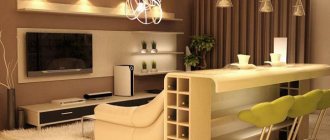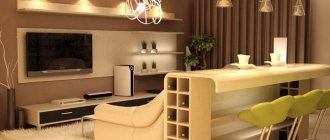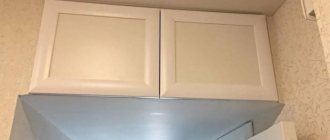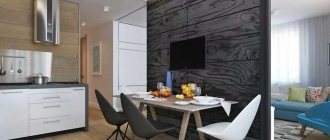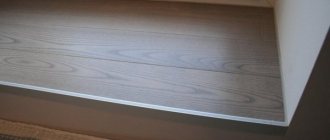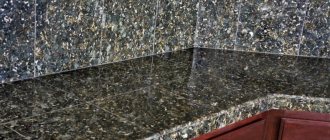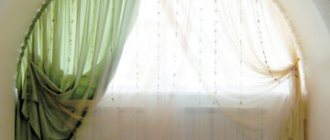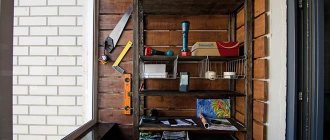The corridor in the apartment is the intersection of all household routes. Wherever you go, your path lies through the corridor. And therefore it is extremely important that this room is comfortably furnished, with compact and at the same time spacious cabinets and drawers.
How to make a mezzanine in the hallway with your own hands, and get a convenient and space-free place to store various things? Read more in today's article.
How to make a mezzanine in the hallway with your own hands?
Peculiarities
Most Russians do not have much room for imagination in the design of their corridors, since they are small in size. And here the time-tested mezzanine helps.
After all, here you need to place hangers, a shoe rack, and many cabinets for storing all kinds of things. It is also necessary to be able to walk freely, because the corridor cuts off all paths from room to room.
We will figure out how to make a mezzanine under the ceiling in the hallway so that it fits organically into the interior of the apartment, what materials to choose for its installation, and we will give examples of how to design a mezzanine in the interior.
Model classification
As for the placement of mezzanines, they can be of two types (they are made to order):
- Rectangular.
- Angular.
Mezzanine above the refrigerator in the beautiful interior of the kitchen of a private house
Wall cabinet above the bed
Depending on the number of doors, there are two types (everyone can see and choose photos of suitable models here):
- One-sided.
- Double-sided.
Mezzanine with one-sided and double-sided doors
According to experts, double-sided models (they can be seen in the photo) are the most convenient to use. When installing a mezzanine, you need to do everything necessary to make it look beautiful and complement the design of the room. This is especially true for rooms with low ceilings.
In them, the mezzanines will be located low, so they will attract surrounding attention. If you place an order, you must indicate the height of the ceilings in the room
Mezzanine in a small bedroom
Doors covered with wallpaper will help the mezzanine fit into the interior
What is a mezzanine
What is a mezzanine? In itself, it is a shelf for things, separated from the common space by doors, located under the ceiling. This is an excellent solution for the corridor, because this is where most rarely used things are most often stored.
In this case, the mezzanine will help preserve free space, while itself taking up space under the ceiling above the door or in a narrow passage. In the past, such a design did not look very good, to put it bluntly, but today it can be properly decorated and will not even attract attention.
How to close
A hallway with open mezzanines can become uncomfortable due to cluttered shelves. Then you will have to make a facade. Doors taken from old unnecessary furniture or purchased separately are suitable. If they open upward, the handles should not hit the ceiling. Another option is to install sliding ceilings.
Doors for the mezzanine.
When it comes to indoor design, the question of combining functionality and style always comes up. If the existing cabinets and bedside tables are not enough, the mezzanine in the hallway already solves the first problem for its intended purpose. And making the right choice, based on the information above and a basic sense of taste, will help give your interior a beautiful look.
Rules for placing a mezzanine
You need to take into account several rules so that your mezzanine does not stand out from the interior:
- The facades and lower part of the structure must match the color of the walls and other furniture in the room.
- The finished mezzanine should not, by sticking out, block the light source, and should not be too large.
- Under the lower shelf of the mezzanine, if it is located in the aisle, a person of even tall stature should calmly pass.
- Do not overdo it with the number of upper shelves in a small room, otherwise you will visually reduce it even more.
Lighting
Lighting plays an important role in the interior of a country-style hallway. It should be represented by both a central ceiling lamp and point light sources.
All lighting fixtures must be selected so that they match the style with the overall design.
It’s just ideal if you buy handmade lamps, or make them yourself using glass, wood, stone, and forged elements.
Massive mezzanines are very rarely organized in offices and living rooms. They can be used to store books, magazines, and collectibles.
In the living room, it is especially important that the upper shelves blend seamlessly with the furniture in the room. The best organization option is tall cabinets, complemented by a mezzanine row under the ceiling.
It is often hot in the upper part of the room, where the mezzanines are located. In order to ensure good air exchange, it is necessary to consider ventilation with an influx of fresh air.
Non-standard solution for children
- organize lighting;
- use a lampshade (preferably matte).
What types of mezzanines exist
Having firmly decided that a mezzanine is your choice, let’s decide which one you need?
Such shelves under the ceiling are divided:
- into closed and open;
- with one or two doors;
- double-sided and one-sided;
- separate or furnished mezzanines.
Let's consider each option in more detail.
Closed and open
Closed mezzanines may have one or more doors. Moreover, the doors can be very different: folding, sliding, hinged - as you wish. A mezzanine in the hallway under the ceiling, the design of which fits into the surrounding space, will become a convenient and stylish addition to other elements of furniture.
With doors, this interior element will more fully match the surrounding style. In addition, this way its internal space will be hidden from prying eyes, which is more aesthetically pleasing and attractive.
Open options are not common, because such shelves under the ceiling filled with things can look untidy. Moreover, they will quickly become a place for dust to accumulate.
There are also options with curtains made of various materials: fabrics, wood or glass beads and others.
With one or two doors
When thinking about a high mezzanine in the hallway under the ceiling, it is worth considering the parameters of the future design. Select the number of doors and the opening mechanism. Doors should not cling to lighting fixtures or other objects. Hinged doors are convenient, but you should think about a locking mechanism.
There can be any number of doors, the main thing is that their dimensions when opening correspond to the surrounding environment.
Double-sided and single-sided
Whether your mezzanine is double-sided or single-sided depends mainly on its location. If the space allows you to conveniently use the structure on both sides, then you can make it with two doors. This way, you will have access to all the things inside and won’t have to reach for them.
But the one-sided option is more common. In this case, access is provided only from one side, from the front.
Separate and furniture
What is a mezzanine in furniture? This is a cabinet structure located on the cabinet itself. In this case, its size and shape will correspond to the cabinet.
If this option does not suit you, then take a closer look at separate shelves installed without other furniture. This hanging structure will save space below.
Main types
Manufacturers produce the following types of structures:
- One-sided.
The doors are located on one side. Therefore, depth is undesirable here - it will be difficult to get things out. The back rests against the wall; One-sided mezzanines in the hallway. - Double-sided. Opens front and back (through). Such mezzanines in the hallway are usually long and roomy. Can be located on both sides of the interior door;
Double-sided mezzanines in the hallway.
- Open. They are cabinets without doors or just shelves. It’s easier to get what you need, but you’ll have to periodically wipe off the dust. Not the best way to store junk, because it will end up on public display;
Open mezzanines. It's not always convenient.
- Closed. Designs with doors. Helps store a large number of household utensils. In addition to aesthetics, this is safety - you don’t have to be afraid that some bottle of solvent will fall on your head;
Closed mezzanines are safe.
- Mounted. Mounted between parallel walls, directly under the ceiling;
Hanging mezzanine in the house.
- Modular. The mezzanine is an element as part of other furniture. Attaches to the very top of the cabinet. A coupe with such a section on top is a good option if there is no suitable space for a mounted model.
Modular mezzanine on the closet.
Selection of materials
The mezzanine is a convenient, compact-looking, utilitarian box. And it is made from different materials. Usually MDF and chipboard are used due to the availability and low cost of these materials. If possible, solid wood is also used, which is superior in quality to the two above options. Drywall is also used, but mostly for exterior decoration. The lining of a mezzanine box is often made from lining.
Let's look at the materials that are most often used to make a mezzanine box.
- Chipboard. A good selection of materials in size and thickness, affordable cost, sufficient choice of shades of laminated chipboard. This means that the material is not so difficult to choose so that it matches the furniture in the hallway. One of the disadvantages is the resins in the chipboard composition, which at first may not emit the most pleasant odor. It is worth remembering that the material is afraid of moisture and cutting it yourself increases the risk of chipping.
- MDF. It is used inside and outside the box, there is a wide choice in terms of colors and dimensions, and it is resistant to moisture. No resins are used during the manufacture of MDF. There will be no unpleasant smell. The material will be highly durable and resistant to mechanical damage. You can count on a long service life. But the price of such a product is higher than that of chipboard, it is heavier, the cutting will have to be ordered at the factory, because it is difficult to do it yourself, without special equipment.
- Array. This is an eco-material, natural, easy to cut and process. You can count on his many years of service. But it is expensive and does not tolerate high humidity well. Excessively dry air will cause cracks to appear. It may become deformed due to temperature changes.
- Drywall. It is relatively cheap, tolerant of moisture and thermal shocks, and easy to handle and install. Lightweight material, but fragile, you need to work with it carefully. Not suitable for foundations, used exclusively for exterior decoration. You will also need to make logs, which will become the support and base of the ceiling box.
When choosing a material, you need to immediately think about what the external finish of the box will be. It should be in harmony with the interior of the room.
Tools and accessories
Initially, the design needs to be thought through, its dimensions and the amount of material needed must be calculated. The best solution would be to make a drawing of the box. You need to make sure that the walls that will hold the box are really strong and can handle the new load.
Tools that will be useful in your work:
- level;
- roulette;
- a screwdriver, or better yet, a screwdriver;
- perforator;
- jigsaw;
- aluminum profile;
- wooden beam;
- dowels, screws;
- pencil;
- necessary fittings, hinges or guides;
- perhaps a click-clack mezzanine bracket will be used.
To this list should be added those items and means that will help decorate the mezzanine.
Manufacturing technology
First you need to determine the place where the electrical wiring runs in the hallway (or at another point in the apartment). If this moment is missed, the cable may be touched during the installation process, which will result in unpleasant consequences. An indicator screwdriver or a special finder, which is sold in any large construction market, will help you find the wiring.
Marking and securing the support
Using a tape measure and a building level, you need to draw a line on the wall in the corridor that will become a guide. Basic fasteners will be mounted along it to support the mezzanine.
- You can use either a wooden beam or a metal corner as a fastening. In the fastener, you need to drill a hole for the self-tapping screw, using a step of 15-20 cm. The part is applied to the line set on the wall, marked through the created holes in the fixation areas in the wall.
- Now you need to pick up a drill and make holes in the wall, put dowels with screws there, and fasten the guides to the wall. The same actions are performed symmetrically on a parallel wall, as well as above the door itself.
- If it is decided to make the box so that it will be covered with plasterboard, logs to the walls are made from aluminum profiles. And then the finished frame can be immediately fixed, sheathed with plasterboard boards or any other identical material, plywood or fiberboard, and sometimes even plastic panels.
- When the support is made, the structure looks more and more like a small box or cabinet. Actually, it will be a small built-in closet under the ceiling. These are made not only in hallways and corridors, but also, for example, in the toilet.
Base installation
From a sheet of the material from which it was decided to make the base, the bottom of the future mezzanine should be cut out with a jigsaw. If the material is chipboard, you can find an already made board of the required size in the construction market. Moreover, you can choose a sample that is finished with an edge, which eliminates the need to decorate this edge. If you decide to saw the slab, you will have to purchase an edge strip.
The bottom is installed in the designated place, secured to wooden slats or corners with self-tapping screws. If the edge of the product is sawed off (that is, there is no edge), the bottom, fixed to the guides, must be moved forward a couple of millimeters. This will make decorating the edge easier. And the edge-tape is glued with glue, forming a neat end. This point of creating mezzanines in step-by-step instructions is one of the simplest.
Door frame assembly
Now we make the side posts and the top of the box. Doors will soon be placed there.
- Mark the desired height from the guides below to the place that will be the top of the mezzanine (or immediately to the ceiling).
- Just as happened with the bottom slats, secure the side racks to the walls. Only wooden beams are used as the material.
- The top bar will complete the installation of the box. It is attached with corners to the side posts.
Hanging door leaves
When the mezzanine has both the box and the base ready, its installation is nearing completion, you need to decide on the doors. And here several perspectives open up. Doors can be made hinged, sliding, or with lifting mechanisms. Depending on this, you can make, for example, a mezzanine coupe, which is relevant today. Especially if there is a cabinet of the same type in the hallway.
- The canvas, which will become the door, can be found in furniture production. You can buy it at a construction market, and the choice in this sense is great today. But if none of the standard blanks fit, there are still options.
- A sheet of chipboard can be cut to its own dimensions, subsequently covering its ends with edge tape.
- If the tape is laminated, it will be connected to the plate using a regular iron. This is not difficult to do, since there is hot-melt adhesive on the back of the edge tape.
- When the doors are ready, you need to figure out which hinges to hang them on, because the choice of door hinges is huge. Card ones are a comfortable option for beginning craftsmen; they can be hung without any problems.
- There is no need to make cuts, which have to be provided in the case of overhead loops. It is very easy to attach the facade to card hinges: this is done using self-tapping screws and a screwdriver.
If this is a door that opens upwards, then you can’t think of better mezzanine hinges. They are also fixed with self-tapping screws, but they have a spring inside the structure that holds the door in the open position. There is also an option for a hinged door that conveniently opens the door upward. A gas elevator is also installed here, that is, a system that will allow the doors to open/close easily. And in the open position they will be securely fixed.
A sliding design is also worth considering, but calling it the most convenient option would be incorrect.
Access to what lies in the mezzanine will be limited to one of the doors. To install such a mechanism, you need to secure special rails/rollers. The double-sided mezzanine is mounted in the same way, except that the opening above the door to the kitchen will not be blocked with bricks or false panels (if repairs require it). When the superstructure is installed in the hallway, the doors on the kitchen side will create a long two-sided mezzanine.
It makes sense to note such an option as curtains.
Until recently, it seemed primitive and did not suit every interior. Today, when many apartments are acquiring eco-style and eco-boho features, curtains instead of doors will look organic in such an interior. They are easy to maintain and can be changed seasonally or for holidays.
We do it ourselves
Such a simple design is easy to make with your own hands. The easiest way: order a cut of laminated chipboard in the desired color, stick the edge tape on the ends and hang the finished doors on the hinges.
You can upholster the plywood with leather or fabric, laying foam rubber between them and making decorative ties. Or assemble doors from wooden slats. There are many options.
We offer you a master class on making mezzanine doors from a special frame profile with filling. A little effort - and they will look no worse than store-bought ones.
Frame MDF profile
You can buy the profile in large hypermarkets, for example, OBI or Leroy Merlin. They come in a variety of colors and shapes, allowing you to choose the right details for your interior.
Any sheet material is used as filling - plywood, MDF, glass, etc.
Doors to the mezzanine with different fillings
In addition to basic materials, you will need:
- Silicone sealant;
- Furniture wax of the same shade as the profile;
- Dowels – connecting fasteners for frames;
Plastic dowels
- PVA glue;
- Furniture hinges with screws;
- Pens.
All this can be bought in the same stores.
Advice. It is advisable to order both cutting and milling of holes for dowels there. Made on special machines, it turns out smoother and more accurate than at home. But for this you need to decide on the sizes in advance.
Machine for cutting frame facades
The table provides detailed assembly instructions:
| Image | Description |
| We coat the ends of the profiles with glue and join them two at a time, collecting the open corners. |
| On the reverse side, we additionally fix the joints with dowels, carefully driving them with hammers into the previously made holes. |
| Squeeze the sealant into the grooves of the frames. |
| We install the sheet filler in one of the corners, then put on the second part of the frame. We are waiting for the glue and sealant to dry completely. |
| We apply furniture wax to the joints, which will mask minor flaws in the assembly and protect the cuts from moisture. |
Note. If the filling is a material whose thickness is less than the thickness of the frame groove (for example, glass), then a special seal is installed on the back side of the insert.
The seal is selected according to the thickness of the glass
Having finished making it, all you have to do is screw the hinges to the doors and install them in place.
Suitable location for the superstructure
So, we’ve sorted out the materials, now we need to think about how our mezzanine will be located and what needs to be taken into account in order to avoid mistakes when assembling and placing it.
As already mentioned, the mezzanine is located under the ceiling in any of the rooms in the apartment, but if it is a corridor, then the most frequently used and convenient place is above the entrance door to the kitchen. When installing the structure, consider some points that you should pay special attention to:
- be sure to think through the design, calculate the dimensions and amount of material required, ideally, create a drawing of the product;
- the depth of the product is also an important point that must be taken into account; if you make the cabinet too deep, it will be very inconvenient for you to get everything you need from it;
- if, nevertheless, you decide to make a fairly deep cabinet, then it is more convenient if you make it double-sided;
- make sure that the walls on which the box will be mounted are strong enough to withstand the load;
- for safety reasons for you and your household, the base material must be durable;
- the mezzanine should fit harmoniously into the overall layout and design of the room;
- the shelf under the ceiling should not interfere with access to the window and the free opening of the door above which it is located;
- be sure to find the location of the electrical wiring in the walls so as not to damage it during installation;
- design the structure so that there is no free space between the top of the drawer and the ceiling, otherwise this space will not be functional, only dust will accumulate in it.
Where to begin?
First of all, you need to decide on the volume of the occupied mezzanine. Its bottom should be located at least 2 meters from the floor level. To make a mezzanine, it is necessary to use high-quality and durable materials that can withstand significant loads.
When choosing a suitable location, you should consider the following recommendations:
- there should be no free space between the ceiling and the top of the structure;
- You should not place the mezzanine near the light source, as the room will become much darker.
Mezzanines are one-sided and two-sided, open, closed and corner. The latter options are more expensive and are installed in those apartments whose layout features prevent the installation of a standard model.
A few ideas for decorating door leaves
If you don’t want your mezzanine to blend in with the furniture, you can take note of the idea for decorating doors.
- You can cover it with artificial leather, laying a layer of foam rubber as a filler. We secure it to the back of the door using a furniture stapler. And if you want your doors to look more pretentious, create the effect of a carriage tie using the same stapler, only from the outside. Decorate the paper clips with leatherette-covered buttons or plastic rhinestones.
- If you glue a mirror sheet to the door, the space in your corridor will visually appear larger and higher. The mirror can be glued using special glue or silicone sealant.
- If you still decide to decorate the doors with wallpaper, then cover them with a layer of PVA glue, which will create a protective film and prolong the beautiful appearance of your product.
What not to do when constructing a mezzanine
It’s not difficult to make an add-on for storing household belongings, but to make the product convenient and functional, you should still take into account the advice of experienced craftsmen:
- you should not place the superstructure lower than two meters above the floor level, otherwise your household members or tall guests risk getting injured when passing by the structure;
- when decorating your new shelf, you should not cover the doors with wallpaper in the same color as the walls, otherwise the design will visually clutter the space;
- in addition, the wallpaper quickly gets dirty, scuffs appear and its attractive appearance is lost;
- at the stage of hanging the sashes on gas lifts or mezzanine hinges, do not open downwards, this option will be extremely inconvenient for use at height, since the ability to get the necessary thing from the depths of the superstructure is limited;
- the mezzanine doors should not touch the chandelier and interfere with the opening of doors to other rooms.
Opening mechanism
Not only design, but also functionality depends on the opening mechanism.
- Swing - attached to hinges, quite convenient and practical. Provide full access to the niche.
- Sliding - installed when there is no room for full opening. They cannot provide full access to things.
If the room has enough free space, you can purchase a spacious and functional mezzanine.
- Folding is a very convenient option for a long mezzanine.
- Lifting up - the door opens up on the fittings. The mechanism prevents it from closing under its own weight, which allows you to fully use the width of the opening. Convenient and reliable, but not cheap.
A corner model is ideal for a small hallway.
Note! Don't make the sashes too long. Over time, they can sag on the hinges. You should also pay attention to the choice of a comfortable handle.
How to design a mezzanine
The mezzanine will look beautiful if it fits harmoniously into the interior of the room. It is desirable that it matches the style and color of the rest of the furniture. This will allow you not to violate the unified design concept. In some cases, the mezzanine may be the same color as the door.
Another option for decorating a mezzanine is to use curtains instead of doors. This technique would be appropriate in boho or Provence style.
The main thing is to choose a fabric that will match the interior elements. For example, sofa cushions or chair upholstery. Instead of regular textiles, you can use roller blinds to match the walls. Thanks to this, the mezzanine will not stand out.
Sometimes mezzanine doors are decorated with mirrors. This allows you to visually increase the space, which is especially important for small corridors.
Selection according to the style of the apartment
The mezzanine will fit into the interior if it matches the color, texture, and design.
Classic requires massiveness and good quality; for this style, only mobile modules are appropriate - extensions of cabinets.
Provence – warm pastel colors and small floral prints. It is appropriate to decorate open or closed structures using the decoupage technique to match the walls. For an open design, original wicker baskets are selected and things are stored in them.
Country style involves the use of natural wood for decoration. A mezzanine made of clapboard would be appropriate above the doors. Corner furniture will fit.
Loft – harmony of lines and free space. Only structures built into wardrobes are suitable.
Minimalism requires conciseness in everything. No pretentiousness, convenience and pragmatism. The structures should not stand out, they should be a continuation of the furniture or walls - the doors and ends are finished as on the walls.
Making sliding doors with your own hands
Sliding doors are very convenient and compact. You can make them yourself using the step-by-step guide:
- You will need a plastic profile with grooves. You need to cut it into two parts along the width of the mezzanine.
- Using a hammer drill, we fix the profiles on the ceiling close to each other.
- We cut out the doors for the structure from chipboard using a jigsaw or circular saw. We carefully process each element on a milling machine. Subsequently, they can be decorated at your discretion. We attach handles for convenience.
- We insert the finished elements into the grooves of the profile, securing them along the contour with a plastic frame. In this case, all extraneous details will be securely hidden.
Ready! Sliding doors should open easily. Check if anything is blocking them.
Creating swing doors
Hinged doors are best made from veneered MDF or chipboard. Less commonly, plastic is used for such products. We cut out the elements of the required size and process them with coarse sandpaper. The front side of the doors can be decorated at your discretion.
Piano hinges are used to secure swing doors. They are first attached to the sashes, and only after that - to the main part of the mezzanine. To ensure that these products are perfectly level, use a building level when working, otherwise your efforts may result in skewed doors.
Don't forget to attach the handles on the outside. To ensure that the doors close as tightly as possible, you can attach a latch and a magnet to the inside.
Global sizes
Length 280 cm - along the entire corridor (in my opinion it’s even 283 cm, but this nuance is not important yet)
Width 148 cm - throughout the entire corridor. + in one place there will already be a (recess) because the portal is from the developer. I don’t want to bother and tear it down.
Height - everything is not so simple here. Ideally, I would like to leave the height of 230 cm for the passage, and give the rest to the mezzanine, BUT:
There will be a suspended ceiling on the kitchen side. It will be 7 cm from the ceiling because there is an electrical system running along the ceiling. The ceiling will be attached to a beam (4x10 cm)
Next there should be mezzanine doors. There will be doors in the style of the kitchen. Kitchen from stolplit. Here is a similar door: the design is different, but the dimensions are the same. And the height of the door is: 355 mm (36 cm)
If you can’t put a door close to the ceiling, it will scrape against it. Give at least 2 cm, that is: 7 cm + 2 cm + 36 cm = 45 cm. There will be another 1 cm at the bottom of the door. Total 46 cm.
we get 270 - 46 = 224 cm instead of the desired 230 cm. I don’t know whether it’s worth being upset about this, and whether it’s worth the trouble to look for a narrower door (a 30 cm door would be ideal)
Advice from the experts
- The bottom of the product must be at a height of at least 2 m from the floor, for the mezzanine - the remaining space above.
- When placing above a door, align the bottom plane of the shelf with the top of the doors. This option is the most practical and looks aesthetically pleasing.
- Do not leave any free space between the top of the structure and the ceiling. This dead zone will only collect dust.
- The mezzanine should not block access to the window or door or interfere with their opening.
- The appearance of the room and its ergonomics should not be compromised. If you hang a shelf incorrectly, it can make the room look too narrow, low, or elongated. Be sure to maintain the effect of open space.
- For a room with high ceilings, you can safely use a gallery mezzanine. This design encircles the room on three sides and is well suited for placing a home library. However, keep in mind that the width of the gallery mezzanine, taking into account the bookshelves, will be about a meter, while the standard shelf size is much smaller.
- Quite often, mezzanines are used in bathrooms and kitchens. Before installing the product, make sure that the wall structure can withstand such a load.
- Most often, mezzanines are placed above the front door. This space under the ceiling is almost never used. To compactly place rarely used accessories, use a spacious mezzanine in the kitchen. This product will free up more space and rid the room of clutter.
- The best place to place a mezzanine is a narrow and long corridor, hallway or living room. There is no need to be afraid that the room will decrease in height, because the shelf will only take up a small part of the wall. Such furniture will help modify the layout and make it more interesting.
Hey you up there!
Unfortunately, the vast majority of apartments with ceiling heights from 250 to 270 cm are practically not suitable for constructing a full mezzanine. But there is the possibility of some clever solutions that can create a mezzanine for a children's playroom. To do this, it is necessary to displace the lower tier.
So, for example, a desktop can be placed on the first tier, and the platform of the second mezzanine tier can be placed at a height of about 170 cm from the floor. Thus, from the cut out meters you can create a platform for installing a mezzanine. And if you move the first tier lower and arrange a small dressing room with drawers there, then the second tier will rise even higher, freeing up space for the mezzanine.
By the way, the area for the mezzanine is optimal with sizes starting from 3.5 m. This will allow you to place a sleeping place or a place for games in it, if we are talking about additional space for children
A cozy mezzanine bedroom always enjoys increased attention and interest among children
mezzanine studio
The design of the studio mezzanine should be openwork and spatial. Therefore, the studio mezzanine must be carefully planned, taking into account the location of particularly loaded areas. Therefore, to create this type of mezzanine you cannot do without stainless steel elements and stairs.
For rooms with sufficient height to accommodate mezzanines, it is possible to create a gallery-type room. This means that the studio mezzanine will encircle the room on both sides. Moreover, one of the sides of the gallery can be expanded into an area where you can place a table, chair and bookshelves.
The use of effective materials - duplex glass and frameless fencing - will completely destroy stereotypical ideas about a closed space. Such “transparency” will eliminate strict confidentiality and introduce a note of openness and trust. It is preferable to use galvanized steel as a material for beams and load-bearing structures. Statically fixed glass railings are installed perpendicular to the longitudinal axis of the roof and floor.
Fastening the mezzanine to a metal profile
Along the perimeter of the bottom of the mezzanine we attach a PN ceiling profile 28 x 27 mm and connect it with crossbars from a PP profile 60 x 27 mm. We hem the bottom of the frame with a sheet of plasterboard. On top we place a flooring made of OSB or thick plywood, rigid enough so that the shelf does not sag under the weight of things.
If there is a significant span of the mezzanine inside, we arrange additional fastening to the ceiling using a suspension. Mezzanine doors are made hinged or sliding. They can be decorated with veneer, self-adhesive film, paper, or simply painted with enamel paint.
After assembling the shelf itself, doors of the required size can be ordered from a furniture workshop, which will not cost much.
Sequencing
- First of all, the place where it is planned to install the mezzanine is marked, indicating exactly where the bottom panel will be placed and how the storage walls will be located.
- Holes are drilled in the wall at the level of the mark showing the lower boundary of the bottom of the structure; the distance between them should be 10 centimeters. Having made holes for the mezzanine in the corridor using a drill, you will be faced with the need to carry out a full-scale cleaning of the room. This can only be avoided if there is a switched-on vacuum cleaner under the device.
- Next, aluminum guides are attached, which should be positioned exactly according to the building level.
- After completing the bottom of the shelf, it is possible to use various materials. Often the bottom of the mezzanine is made of plywood, but this material can sag under the weight of the contents. Therefore, it is preferable to use boards, both regular and floor and wooden lining. It should be remembered that the walls in houses are in most cases uneven, so it is advisable to make all the planks so that they fit exactly into the space intended for them. This design will look best. The boards must be completely dry!
- The elements of the bottom of the structure are placed on the corners; the very last board should be given a shape that coincides with the edges of the corners. Each of the strips must be secured with four self-tapping screws.
- After this, the bottom of the mezzanine is finished either by painting, or by varnishing, or by covering it with plastic panels.
- Now the door frame structure is being made; it is made of narrow planks.
- Next, it is attached to the walls, giving the door frame a configuration that matches their shape
- Finally, the doors are attached to the hinges in the door frame. Doors can be hinged or sliding. If the mezzanine is open. then you won't need doors.
- If desired, you can line the mezzanine, for example, by finishing the structure with PVC panels.
The shelf is ready, now you have additional space for storing accessories of a wide variety of types. With the help of a mezzanine, you will occupy a previously unused volume of the room, thereby saving space.
